Related Research Articles

Ephrem the Syrian, also known as Saint Ephrem, Ephrem of Edessa or Aprem of Nisibis, was a prominent Christian theologian and writer, who is revered as one of the most notable hymnographers of Eastern Christianity. He was born in Nisibis, served as a deacon and later lived in Edessa.
The Saint Thomas Christians, also called Syrian Christians of India, Marthoma Nasrani, Malabar Nasrani, Malankara Nasrani or Nasrani Mappila, are an ethno-religious community of Indian Christians from the state of Kerala, who currently employ the East Syriac Rite and West Syriac Rite liturgical rites of Syriac Christianity. They trace their origins to the evangelistic activity of Thomas the Apostle in the 1st century. The Saint Thomas Christians had been historically a part of the hierarchy of the Church of the East but are now divided into several different Eastern Catholic, Oriental Orthodox, Protestant, and independent bodies, each with their own liturgies and traditions. They are Malayali people and speak the Malayalam language. Nasrani or Nazarene is a Syriac term for Christians, who were among the first converts to Christianity in the Near East.

Saint Anastasius of Persia, was originally a Zoroastrian soldier in the Sasanian army. He later became a convert to Christianity and was martyred in 628.
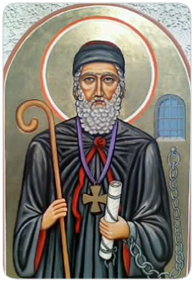
Aba I or Mar Abba the Great was the Patriarch of the Church of the East at Seleucia-Ctesiphon from 540 to 552. He introduced to the church the anaphoras of Theodore of Mopsuestia and Nestorius beside the more ancient liturgical rite of Addai and Mari. Though his tenure as catholicos saw Christians in the region threatened during the Persian-Roman wars and attempts by both Sassanid Persian and Byzantine rulers to interfere with the governance of the church, his reign is reckoned a period of consolidation, and a synod he held in 544 as instrumental in unifying and strengthening the church. In 544 the Synod of Mar Aba I adopted the ordinances of the Council of Chalcedon. He is thought to have written and translated a number of religious works. After his death in February 552, the faithful carried his casket from his simple home across the Tigris to the monastery of Mar Pithyon.

Asoristan was the name of the Sasanian province of Assyria and Babylonia from 226 to 637.
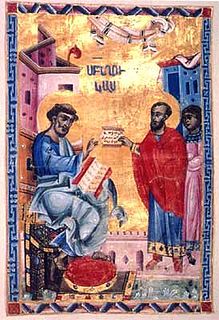
The Acts of the Apostles is a genre of Early Christian literature, recounting the lives and works of the apostles of Jesus. The Acts are important for many reasons, one of them being the concept of apostolic succession. They also provide insight into the valuation of "missionary activities among the exotic races," since some of them feature missionary work done among, for instance, the Cynocephaly.

The Council of Seleucia-Ctesiphon, also called the Council of Mar Isaac, met in AD 410 in Seleucia-Ctesiphon, the capital of the Persian Sassanid Empire. Convoked by King Yazdegerd I (399–421), it organized the Christians of his empire into a single structured Church, which became known as the Church of the East.
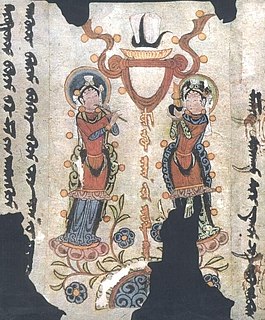
Mar Ammo was a 3rd-century Manichean disciple of the prophet Mani. According to Manichaen tradition he spread Manichaeism eastward into Sogdiana during the time period when Mani was living. Mar Ammo is well known as the apostle of the east in Manichean literature nevertheless his exact origins are unknown. His Syriac name may denote that he was Aramaic in origin. However, a Parthian origin may also be seen and is mentioned by some scholars, especially due to his outstanding role in establishing the Parthian language as the official language of the eastern Manichean Church, later to be replaced by Sogdian in the sixth century. Furthermore, Mar Ammo is widely regarded as the composer of the Manichaean Parthian hymn-cycles.
Sabrisho I was Patriarch of the Church of the East from 596 to 604, during the rule of King Khosrau II.
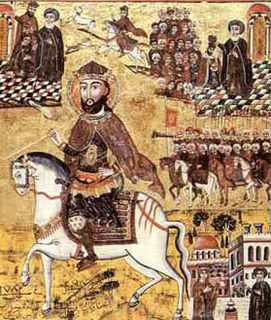
Saints Behnam, Sarah, and the Forty Martyrs were 4th-century Christians who suffered martyrdom during the reign of Shapur II. They are venerated as saints in the Oriental Orthodox Church.
Mār Qardāgh, was a legendary Assyrian prince who was martyred for converting to Christianity.
George of Izla was an East Syriac martyr, theologian and interpreter. He was mainly remembered for his role in a royal disputation which eventually led to his execution.
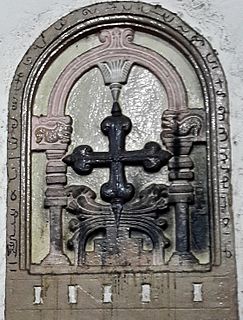
Several historical evidences shed light on a significant Indo-Persian ecclesiastical relationship or the Malankara–Persia relationship that spanned centuries. While an ecclesiastical relationship existed between the Saint Thomas Christians of India and the Church in Sassanid Empire in the earlier centuries, closer ecclesiastical ties developed as early as 4th century. In the seventh century, India became an ecclesiastical province of the Church of the East and it endured until the Portuguese colonial invasion of Malabar in 16th century. The Christians who came under the two ancient yet distinct lineages of Malankara and Persia had one factor in common: their Saint Thomas heritage. The Church of the East shared communion with the Great Church until the Council of Ephesus in the 5th century, separating primarily over differences in Christology.
The Acts of Shmona and of Gurya is a Syriac Christian martyrdom text. The setting takes place at Edessa during Roman Emperor Diocletian's Great Persecution.
The Martyrdom of Simeon is an account concerning the martyrdom of Simeon or Shemon Bar Sabbae, a leader in the Church of the East under the Sasanian Empire. It is one of four Syriac martyr acts, and also known by its longer name, The Martyrdom of Mar Simeon, the Archbishop of the Church of the East. It is not to be confused with the History of Simeon, another narrative about the same individual. There are conflicting chronological notes in the relevant ancient sources, but the death of Simeon must be placed in the neighborhood of 344 CE.

The Chronicle of Arbela claims to record the early history of Christianity in the city which is now known as Erbil, Iraqi Kurdistan, but which was then Arbela, capital of Adiabene. First published in 1907, its age and historicity are disputed among scholars.
Wēh Antīōk Khosrow, also called Beh-az-Andīw-e Khosrow, Antiocheia Chosroou (Greek), Rūmagān, or al-Rūmīya, was a city founded by Khosrow I on the east bank of the Tigris in the vicinity of Ctesiphon, Sasanian Empire, that was populated by deported Roman prisoners-of-war. It was reportedly about one day's walk from Ctesiphon.
Miles, sometimes Mar Miles, was the bishop of Susa in Sasanian Persia from before 315 until his martyrdom in 340 or 341. He engaged in efforts to evangelize Susa, traveled widely in the Eastern Roman Empire and led the opposition to Papa bar ʿAggai and the supremacy of the bishops of Seleucia-Ctesiphon in the Persian church. He was executed by the Sasanian authorities at the start of the Forty-Year Persecution.
The History of Mar Qardagh is a Syriac martyrdom text pertaining to Qardagh, a Sasanian military leader and noble who converted from Zoroastrianism to Christianity. Though the narrative of the text is set during the reign of Shapur II, it was written in the final decades of the Sasanian Empire.
Barshabba, whose name means "son of the deportation", was the first recorded East Syriac bishop of Merv. He attended the synod of Patriarch Dadishoʿ in 424. Barshabba, or at least his name, lies at the root of an elaborate legend about the introduction of Christianity to eastern Iran and central Asia.
References
- ↑ Kyle Smith (19 January 2016). Constantine and the Captive Christians of Persia: Martyrdom and Religious Identity in Late Antiquity. University of California Press. p. 144. ISBN 978-0-520-96420-4.
- 1 2 Richard W. Burgess; Witold Witakowski (1999). Continuatio antiochiensis Eusebii. Franz Steiner Verlag. p. 257. ISBN 978-3-515-07530-5.
- ↑ General History of the Christian Religion and Church. Crocker & Brewster. 1855. p. 110.
- ↑ Albert Hauck (1910). The New Schaff-Herzog Encyclopedia of Religious Knowledge: Embracing Biblical, Historical, Doctrinal, and Practical Theology and Biblical, Theological, and Ecclesiastical Biography from the Earliest Times to the Present Day. Funk and Wagnalls. p. 219.
- ↑ L. Van Rompay, "Shemʿon bar Ṣabbaʿe" in Gorgias Encyclopedic Dictionary of the Syriac Heritage: Electronic Edition, edited by, Sebastian P. Brock, Aaron M. Butts, George A. Kiraz and Lucas Van Rompay, last modified 2016-09-22-16:00.
- ↑ Holy Women of the Syrian Orient. University of California Press. 28 August 1998. p. 64. ISBN 978-0-520-21366-1.
- 1 2 3 Joel Walker (24 April 2006). The Legend of Mar Qardagh: Narrative and Christian Heroism in Late Antique Iraq. University of California Press. p. 222. ISBN 978-0-520-24578-5.
- ↑ Eva Riad (1988). Studies in the Syriac preface. Uppsala University. p. 133. ISBN 978-91-554-2254-7.
- ↑ Shahbazi, Shapur (2003). "Shapur I". Encyclopedia Iranica. Costa Mesa: Mazda.
- ↑ Michael Burgan; Thomas G. Urban (2009). Empires of Ancient Persia. Infobase Publishing. p. 68. ISBN 978-1-4381-2784-2.
- ↑ For the deportations under Shapur I, from eastern Roman provinces, see Richard Kalmin (26 October 2006). Jewish Babylonia Between Persia and Roman Palestine. Oxford University Press, USA. p. 7. ISBN 978-0-19-530619-4.
- ↑ For Shapur II's fighting with Rome, and his deportation of Armenians, see Jacob Neusner (27 October 2008). A History of the Jews in Babylonia, Part IV: The Age of Shapur II. Wipf and Stock Publishers. pp. 15–17. ISBN 978-1-60608-077-1.
- ↑ Joel Walker (24 April 2006). The Legend of Mar Qardagh: Narrative and Christian Heroism in Late Antique Iraq. University of California Press. p. 222. ISBN 978-0-520-24578-5.
- 1 2 3 4 Beate Dignas; Engelbert Winter (13 September 2007). Rome and Persia in Late Antiquity: Neighbours and Rivals. Cambridge University Press. p. 260. ISBN 978-0-521-84925-8.
- ↑ D. T. Potts (12 November 2015). The Archaeology of Elam: Formation and Transformation of an Ancient Iranian State. Cambridge University Press. p. 682. ISBN 978-1-316-58631-0.
- 1 2 3 Augustus Neander (1855). General History of the Christian Religion and Church. Translated by Joseph Torrey. Crocker & Brewster. pp. 110–111.
- ↑ Mary Boyce (2001). Zoroastrians: Their Religious Beliefs and Practices. Psychology Press. pp. 119–. ISBN 978-0-415-23902-8.
- ↑ Joyce E. Salisbury (2001). Encyclopedia of Women in the Ancient World. ABC-CLIO. p. 211. ISBN 978-1-57607-092-5.